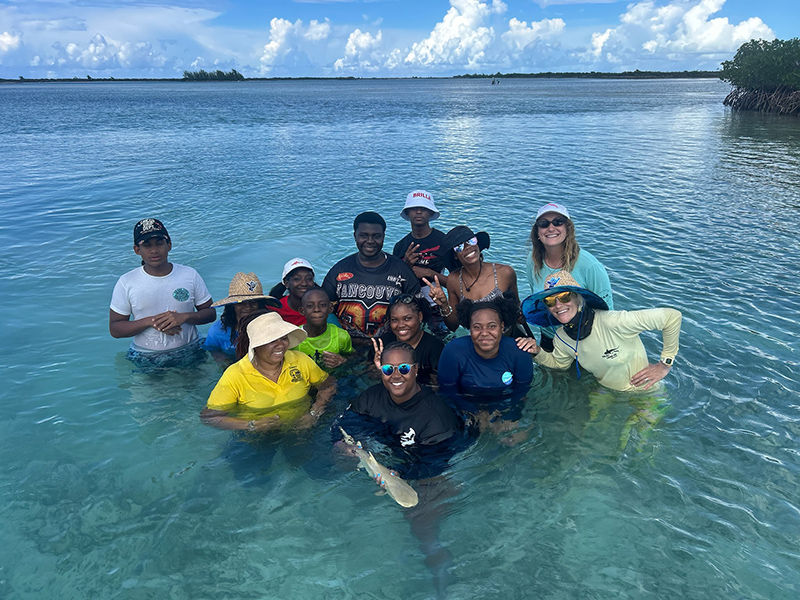Shark Tagging Day with Sharks4Kids
- Sharks4Kids

- Oct 5, 2024
- 4 min read
Author Stephanie Huynh
Our ambassador, Stephanie, was able to join our Shark Research Day with the Field School/UM Shark Research Program. Here she shares her experience.
Tagging sharks and observing marine biologists who work closely in the field with these fascinating creatures was something I’ve been trying to participate in for the past few years. As with anything else, seeing it televised (such as on Shark Week) is simply not the same as firsthand experience. I can confidently attest to this from being in the water and personally interacting with sharks on several occasions as a recreational scuba diver. Unfortunately, a few seemingly promising opportunities that came my way did not pan out in my favor for various reasons. Luckily, the stars aligned properly and thanks to Sharks4Kids and the Field School in Miami, I was granted the chance to not only observe marine biologists but to participate in shark tagging, data collection, and biological workups of these animals.
Alongside several other eager shark enthusiasts like myself, we set sail early one extremely muggy July morning out of the marina in Miami aboard the research vessel R/V Garvin. With beads of sweat collecting beneath our Sharks4Kids sun shirts, it didn’t bother us in the least as we were about to learn and contribute to the science that will help protect the vital creatures that we so love and adore. The team from the Field School and their interns were more than accommodating to help us understand their work. They were clearly passionate about their objectives, our safety, and the safety of the sharks we were hoping to see up close and personal.
One of the first tasks they taught us was how to deploy drumlines, buoys, and baited longlines to lure the sharks in. Throwing these heavy things overboard and later retrieving them by tugging on a heavy rope that felt like elementary school field day tug-of-war surely gave us our full body workout for the day! It didn’t take long before … voila! Our first shark appeared.

Buoys ready for the drum lines
This was our largest catch of the day and therefore the scientific workup had to be done on a platform off the side of the boat rather than bringing the shark up onto the boat. It was an attractive nurse shark who was 222 cm in total length. (I’m not sure why, but I remembered that specific length!) As passive and docile as nurse sharks tend to be in their natural habitat, trying to handle one, especially in an unfamiliar environment, turned him into an unhappy camper. It took about 4 people to keep the shark calm and prevent him from resisting the biological workup to be performed. My job with this first shark was to take a small sample of the tip of its 2nd dorsal fin by clipping it with a pair of scissors. It felt like cutting cardboard. Once clipped, I placed it in a test tube and it was good to go!

Setting drum lines
Following this nurse shark we caught and released 6 more sharks. They included 2 blacktip and 4 blacknose sharks. All of them were small enough to be brought on board and placed on top of a small cooler to do the work up. All the sharks that were brought onboard were obligate ram ventilators, meaning they have to continually swim in order to breath. To compensate for this out of water experience, the team would insert a hose of running water into the shark’s mouth to keep water flowing continuously over the gills to allow for uninterrupted breathing. They informed us that the workups must be completed in 5 to 7 minutes to cause as little stress to the animals as possible. They also assured us that all the clippings and pokings that we were doing would not hurt the sharks as they have a significantly lower number of pain receptors than we do.

Stephanie assisting with length measurements during a scientific workup
In addition to fin clippings, other jobs we volunteers were asked to do included taking 3 different body length measurements, inserting the tag into the 1st dorsal fin, and checking for parasites which, if found, were collected and placed in test tubes to be analyzed by the research team later. Blood drawing was another job but only performed by the Field School team.
As I held the measuring tape flat against the flank of a petite blacknose shark, I gently stroked its skin with my thumbs in the direction from tail to head. I wanted to feel the sensation of its dermal denticles which was something I was always curious about but would never be able to do during a shark dive for obvious reasons. It felt exactly like sandpaper.

Stephanie taking a DNA sample during a scientific workup
In conclusion, my day spent as a citizen scientist collecting data and samples from local Miami sharks under the blazing Florida sun was an exhilarating experience. Well worth traveling about 90 miles out of my way from my usual frequently visited spot in Florida. This experience has also given me clearer insight on what marine biologists actually do out in the field and firsthand experience of how exhausting it is! I now have a whole new level of admiration and respect for those who have chosen this career path in marine biology whether it be to restore coral reefs, save mangrove habitats, or protect vulnerable marine wildlife such as the amazing creatures we call sharks.





















